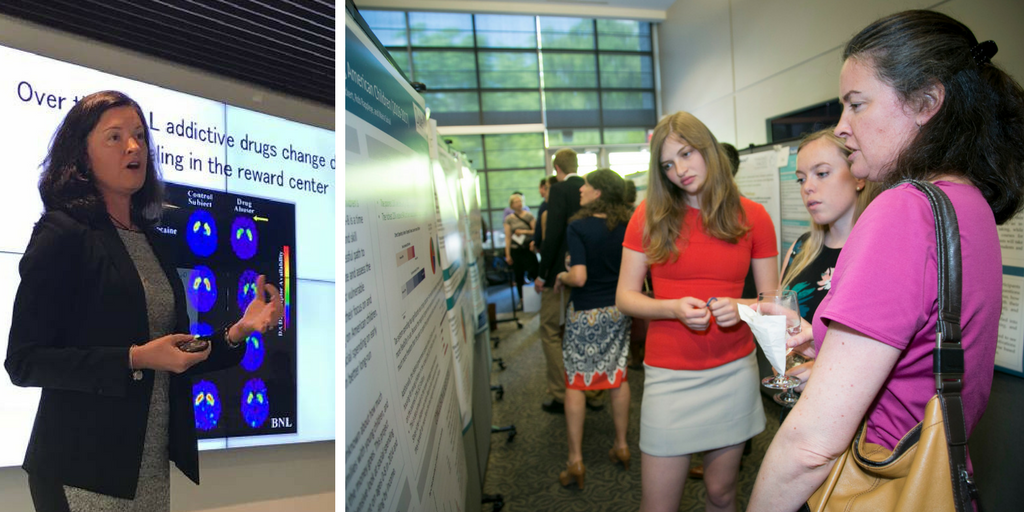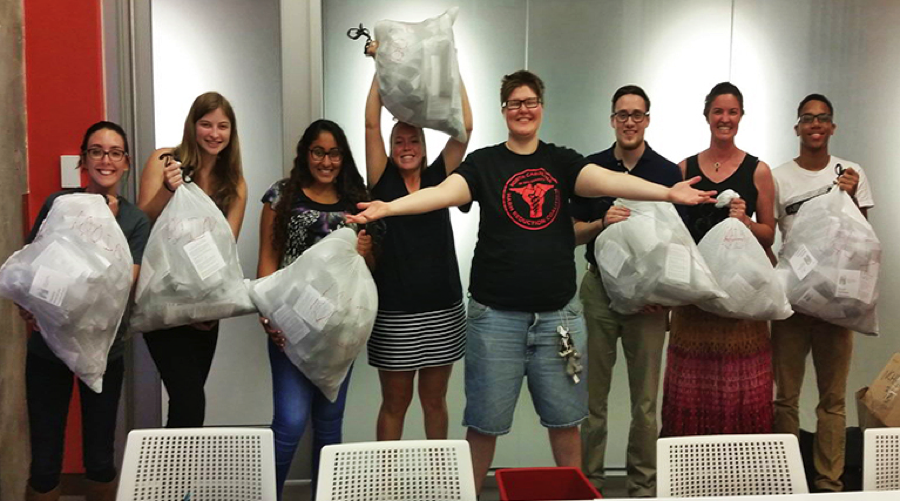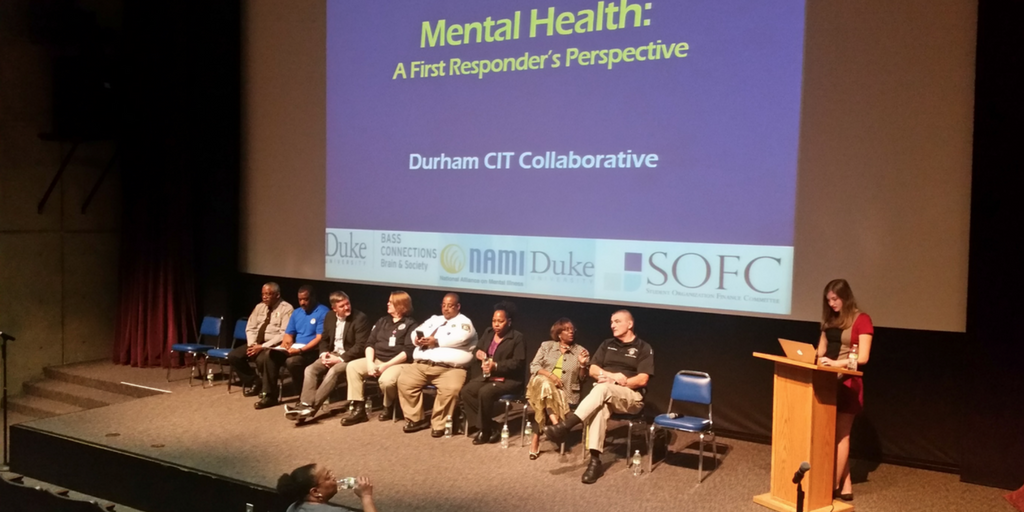Turning Ideas into Action: Tackling the Opiate Epidemic in North Carolina
April 13, 2018
By Katie Kanter ’18
 “Let’s start by naming ten ideas – ten things you want to do to impact the opioid epidemic. They can be as big or as small as you want.”
“Let’s start by naming ten ideas – ten things you want to do to impact the opioid epidemic. They can be as big or as small as you want.”
Five undergraduates, two grad students, a neuroscience professor and a pharmacist. We, the new members of the Stemming the Opiate Epidemic through Education and Outreach team, had all just met that morning, uncertain what Bass Connections would allow us to do but all eager to have an impact on the opioid crisis in some way.
I thought back to my team interview when I asked Nicole Schramm-Saptya and Andrew Muzyk – the professor and the pharmacist – where they envisioned the project going, expecting an answer with a very local scope. No. They wanted the project to go as far as the entire state of North Carolina.
Sitting in that room, surrounded by empty whiteboards waiting to be filled with ideas of anything, literally anything, that we thought could bring about positive change, I was entirely overwhelmed. I wrote in my reflection from that first summer, “Having watched the opioid epidemic get more attention in the media, especially over the past year, I was not sure how a team of Duke students and professors would possibly be able to fit in.”
At the time, the opioid epidemic was just emerging into national headlines as death tolls for both prescription opiates and heroin were at all-time highs with no signs of slowing. Not only was the epidemic growing, but it was also evolving as fentanyl and other synthetic opioids were hitting the streets, lacing “normal” heroin doses with lethally high levels of increasingly stronger drugs.
How were we supposed to do anything to change something on such an incredible scale?

When I talk about my Bass Connections project it is difficult to put into words how much my team took to heart the model of undergraduate-driven research. Everything that we have accomplished – every success and failure – has been devised completely from scratch, beginning with this simple conversation about ideas.
In the summer of 2016, our team met with dozens of community stakeholders – doctors, people in recovery, directors of recovery facilities, statisticians, law enforcement officials and others – revising and revisiting ideas from that first meeting while continuing to add more to an ever-growing list on ideas and possible interventions. Our GroupMe gallery from that first summer is filled with pictures of whiteboards with lists, thought webs and maps of our team in relation to these stakeholders. We started by taking it all in – this growing opioid epidemic – from every angle that we could, but it took us a long time to finally get our footing and find our place.
It is difficult to compile a full list of all of the ideas we have had over the past two years, but, in order to highlight some of our team’s successes and failures, I want to take a look at nine of our big ideas and show how they fared, for better or worse. To me, this list, complete with successes and failures, demonstrates an evolving understanding of the opioid epidemic as well as a growing understanding of the communities with which we worked.

Idea #1: Assemble over 600 naloxone rescue kits with the North Carolina Harm Reduction Coalition.
This idea was a success! In the summer of 2016, our team assembled 624 kits that were distributed to at-risk populations free of charge. The next summer, we did it again.
Idea #2: Devise and film a public service announcement (PSA) to humanize the four out of five heroin users who started with prescription pills.
This idea didn’t work, because our PSA ended up looking more like an advertisement for using than anything else.
Idea #3: Lobby the North Carolina state legislature to formally legalize syringe exchange programs.
Another huge success. On July 11, 2016, North Carolina Governor Pat McCrory signed a bill legalizing syringe exchange programs throughout the state.
Idea #4: Develop resource cards to cover all free sexually transmitted infections (STI) testing locations, detox facilities and in-patient treatment facilities in the entire state of North Carolina.
Unfortunately, this hard work was ultimately a failure, because many of the facilities listed were later found to have closed, and the cards were not disseminated nearly to the extent we had hoped.

Idea #5: Cultivate a partnership with the Durham Crisis Intervention Team (CIT).
This partnership has been a cornerstone of our work. Not only did our team hold a panel discussion on campus to acknowledge the great work that the Durham CIT collaborative has done for mental health and first responders, but we also branched off into a Summer 2017 Data+ team that performed a data-driven analysis of mental health intervention practices by Durham Police. This summer, Durham CIT will again partner with Data+ to consult on the effectiveness of CIT’s specialized training.
Idea #6: Coordinate Mental Health First Aid workshops on campus with the help of CIT-trained first responders at Alliance Behavioral Healthcare.
This was another success. We held our first workshop this fall and we’re planning additional workshops for undergraduates, medical students and nursing students.

Idea #7: Write a grant proposal for private funding to change the process by which naloxone is disseminated in the Duke Hospital Emergency Department.
This was a failure, and our team did not receive funding.
Idea #8: Turn our failed grant proposal into fuel to effect change in the Emergency Department (ED), anyway.
Success! Rethinking our approach, we created patient education materials that will now be disseminated into the Duke University Health System. Pending the approval of ED leadership, thousands of doses of free Narcan (a common brand of naloxone) will be available to patients. Additionally, our ED advocates will participate in prescriber education and the order set we developed for EPIC (a health record technology system) will completely change the process whereby naloxone is prescribed.
Idea #9: Publish research in the North Carolina Medical Journal using publicly available data.
Stay tuned: Our article will be released in May!
In sum, Bass Connections has allowed me to be a part of an interdisciplinary team that has had its hand in too many projects to count, encompassing a variety of the perspectives from which you can tackle the opioid epidemic. Through success and failure, we have done work that has been very local – reaching as far as Duke’s campus – but we’ve also completed projects that can affect the entire state.
As I apply for gap year jobs in opioid research, I am quickly realizing that there are very few opportunities that will allow me to be a part of every facet of a large project – jobs that don’t require pigeonholing my focus into only one small specialty or niche. There are dozens of perspectives to the story of the opioid crisis, and my Bass Connections team has given me the incredible opportunity to have a hand in many parts of this story all at once. I am extremely thankful for this unique and rewarding experience.
Learn More
- Join us at the Bass Connections Showcase on April 18, where Katie Kanter and teammate Madeline Thornton ’18 will give a short talk highlighting their team’s two years of research.
- Check out Bass Connections in Brain & Society teams at the Duke Institute for Brain Sciences (DIBS) Discovery Day on April 15.
- Browse additional stories from students on their Bass Connections experience.
Photos: Team leader Nichole Schramm-Sapyta presents the team’s work at a conference in DC; Katie Kanter (red shirt) and teammates examine their poster at the 2017 Bass Connections Showcase; Kanter (second from left) helps assemble naloxone kits in the summer of 2016; Kanter (at podium) presents with members of Durham CIT; Workshop attendees participate at one of team’s first Mental Health First Aid events.
